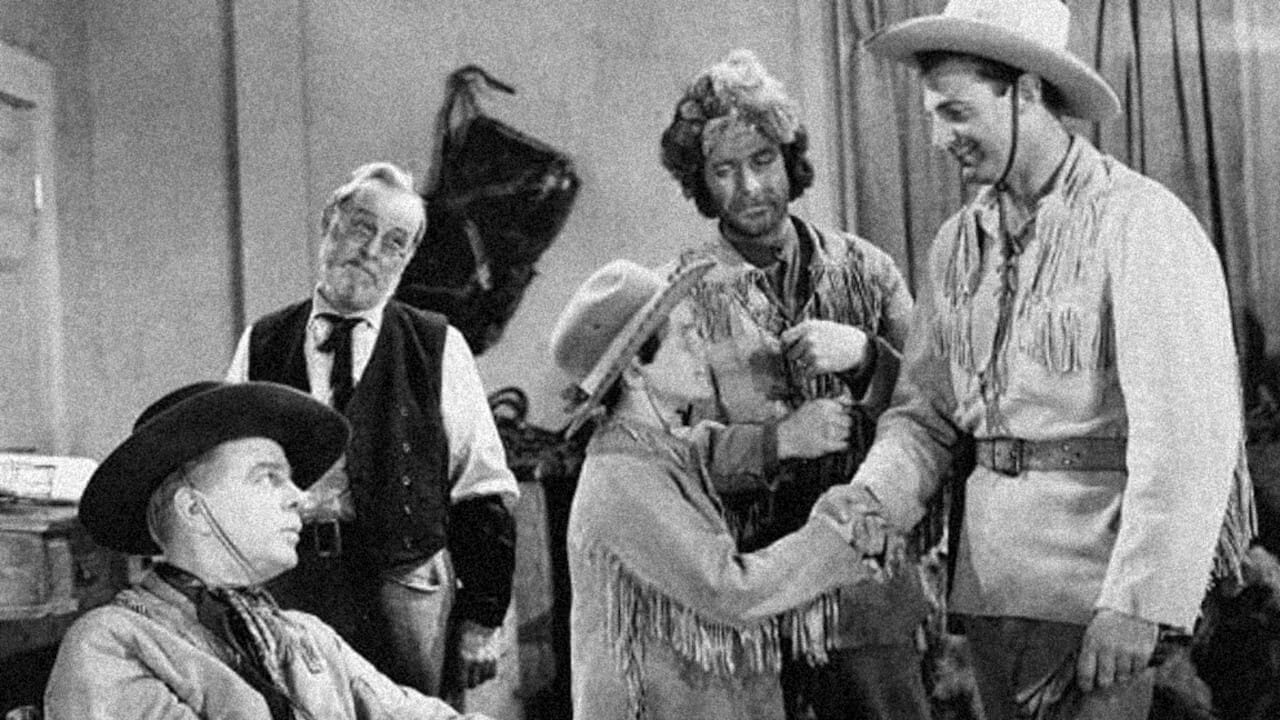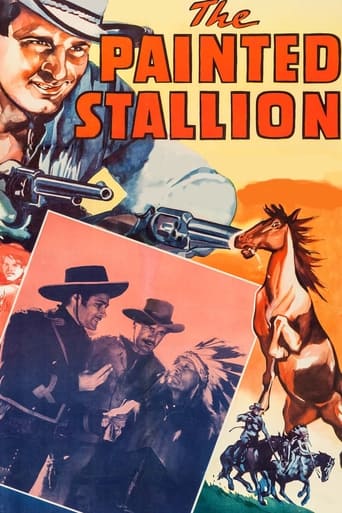

I always suspected that directors Ray Taylor and William Witney handled the main location unit, while Alvin J. Nietz (under his "Alan James" pseudonym) handled a second location unit that staged all the copious action and thrilling stuntwork. It seems I was right. And I was also right in guessing that Ray Taylor's contribution was rather small. Taylor was actually fired by producer J. Laurence Wickland early on for drinking on the location set and was then replaced by Witney who was at that time acting as a script supervisor and prompter. Part of Witney's duties were to rehearse the players, so he was the obvious person to select when Taylor was fired – particularly as Nietz had his hands full with all the action material. The serial, in fact, is crowded with action – which is just as well as the plot features a juvenile Kit Carson played by Sammy McKim (who appeared in no less than 62 movies, in around half of which he was uncredited). Personally, I never did take kindly to juveniles in serials. Nevertheless, despite this introduction of a juvenile Kit Carson into Chapter One, that first chapter is certainly packed with action – a judicious blend of new and stock material. Incidentally, take note of all the thick black smoke pouring from the riverboat's funnel. Health conscious, those old steamers most certainly were not! Anyway, getting back to the early chapters of this serial, Hoot Gibson – despite his co-star billing (in much smaller print) – has very little footage. Charles King, on the other hand – despite being billed second last – has a major role. Keen fans will keep their eyes out for Lafe McKee's river boat captain. He hovers at the edge of just two or three shots and has a line or two to offer Ray Corrigan. There are so many things happening in this serial that I almost forgot to mention that fascinating singing arrow in the hands of the lovely Julia Thayer. Wow! But I did deliberately forget to mention Ed Platt and Lou Fulton's boringly inept turns as Oscar and Elmer. They are a pain, but at least their appearances are brief and I'm happy to say that despite an elaborate introduction to each episode, they often don't appear at all. I'm not alone in my belief that the best episodes are the first five. Once the expedition reaches Santa Fe, the action melts down quite a bit. The serial is still very watchable but nowhere near as impressive as the earlier chapters, so it's no wonder the setting resumes to the rugged mountain locations for the final episodes. It's also no surprise to find the 80-minutes 1938 feature cutdown omits all the Santa Fe footage completely. Although I enjoyed the serial very much and I'd definitely place it amongst Republic's best in this genre, I do have some reservations. Number one, it was disappointing to see Hoot Gibson in such a small role. Admittedly, he's on screen in many episodes, but he has nothing Hootish to do at all. Any actor from Central Casting could have done as well. Hoot was obviously hired on the strength of his name after the screenplay had already been written and no attempt at all has been made to insert any special material for him. Instead, Charles King – although billed second last in the entire line- up – has acres of typical Charles King lines and action. I'll admit that Ray Corrigan makes almost as little impression as does Gibson, but Corrigan never did have a strong on-screen persona. Even in his long- shot, seven seconds walk-on, Lafe McKee displays more color and character than Corrigan does for the entire movie. A weak hero has to be bolstered and this was cleverly achieved by assembling westerners like Jim Bowie, Davy Crockett and most importantly a young Kit Carson. If this had not been done, it would have enabled the villains, led by LeRoy Mason, to take center stage. I'm sure someone at Republic noticed that the initial script had problems and that explains why to balance our heroes, the lovely Julia Thayer's mysterious rider with her whistling arrows was also written into the plot. An inspired invention! My hat's also off to Alvin J. Nietz who has done wonders with his second unit. Wow! Those scenes with the wagon charging right into the camera! And the numerous running inserts Words fail me!
... View MoreLou Fulton, fortunately, only made a small number of film appearances--and they were mostly in westerns. He played a VERY offensive and unfunny guy named 'Elmer'--a guy who stutters and contorts his face in a palsied manner and seems almost subhuman--all in the name of laughs! His appearance in "The Painted Stallion" is a major strike against this movie serial. Are the rest of the cast up to the task of making the viewer forget about Fulton's ridiculously bad acting? This western serial is apparently set around 1820. So, you see Jim Bowie and Davy Crocket--the same men who died at the Alamo in 1836. Yet, despite being such a very, very early western, you'd never know it because everyone fires revolvers and wears cowboy hats--which hadn't yet come into use. The earliest revolvers were being invented then and each chamber was hand-loaded (there were no cartridges) and a gun might be fired five or six times--but then took several minutes to reload. Well, that's NOT the case here, as the Colt .45 and other anachronistic weapons were used throughout the film. I know many viewers won't care about this sort of thing, but seeing clothing and guns from 30-40 years in the future annoys me--probably in part because I am a retired history teacher. Get it right folks--it just means doing a tiny bit of homework before you make the film.As far as the acting goes, I was a bit disappointed. Although Ray Corrigan was the leading man, I assumed it was more an ensemble cast with his buddy, Hoot Gibson, getting equal treatment in the film--and I liked this thought since I really like Hoot Gibson films. Well, Gibson was pretty much a minor character. I also didn't like all the attention the kid (who was SUPPOSED to be a young Kit Carson) got in the film--as most child actors are pretty annoying. So, with these folks starring in the film, it's obvious that Fulton's bad acting would NOT be overshadowed by the rest of the cast--since the cast were all semi-mythical representations of real western characters. Carson, Bowie and Crocket did NOT pal around together! Overall, this isn't a terrible western serial, but it isn't all that good of one either. There are many dull patches, the reuse of scenes for the sake of economy and the mistakes I've already mentioned. While most serials were rather slapped together and often played loose with the facts, even without all this the serial wasn't nearly as interesting as many others such as "The Adventures of Captain Marvel" or "Spy Smasher". Worth a look only if you are a devoted serial junkie.
... View MoreThough no years are actually mentioned the time that the action of this serial takes place is 1821 when Mexico gained its independence from Spain. LeRoy Mason and his chief henchman Duncan Renaldo have been running things for the Spanish government in Santa Fe, but now with a new country and a shift in power, their position is compromised purportedly.Of course this is of some interest in Washington, DC where the president would have been James Monroe and the Secretary of State John Quincy Adams. They send Ray Corrigan on a diplomatic mission to negotiate a trade treaty for Americans in Santa Fe.Ray Corrigan may have been the most unusual diplomat ever sent on a trade mission by our State Department. Instead of going to Mexico City to negotiate with the government there, he's sent to Santa Fe to deal with provincial officials. And of course every diplomat I know comes not only with letters of credentials, but six guns and buckskins. Six guns, by the way, that Samuel Colt has not invented yet.Corrigan hooks up with a wagon train headed by wagonmaster Hoot Gibson. Also along for the ride are scouts Davy Crockett and Jim Bowie who never met until the Alamo and also there's young scout-in-training, Kit Carson. Gibson and Corrigan with the aide of their trusty scouts and a mysterious Indian princess who rides a painted stallion and shoots 'singing' arrows get the wagon train through and then have to deal with the bad guys after getting to Santa Fe.Every time I see one of these old movie serials I am astounded at how bad they are. Forget Olivier and Brando, the guys who had to say some of this dialog with a modicum of sincerity may be the greatest players the world has ever known. I can't see how the cast kept a straight face.I guess this only proves one thing, one of the qualifications of a U.S. diplomat back in the day was one's ability with a six gun. And seeing how Ray Corrigan constantly got himself out of one scrape after another, John Quincy Adams would have been proud.
... View MoreOver the years, I found myself daydreaming about this serial from time to time. It was my introduction to the Saturday matinee habit which followed for five or six more years. Later, with the advent of VCR's I learned that a copy of this serial was available and it now occupies a spot on my videotape library shelf. I'm still of two minds as to whether the purchase was a wise or foolish move. I must admit that I did enjoy the regular dosage of suspense. These closers recalled the discussions my chums and I would have trying to resolve the hero's predicament before the next Saturday. Occasionally we would recall the two or three scenes which were added to the story but had been omitted from the end of last week's chapter. Still and all, we didn't complain and felt that our 10¢ had been very well spent. The viewing of the serial several decades later was, on the whole, a disappointment. The reason is that in 1938, I was always allowed to spend a week in suspense, sounding out my buddies' soutions and comparing them with mine. The following Saturday, of course, the solution was revealed. As for the story itself, I identified with the boy hero completely. The light-hearted comic relief was much appreciated as well and served to ease the tension of the exciting segments. The concluding chapter when "all was revealed" was always a disappointment for I had already conjured up a solution far more exciting and thrilling than the one the writers ever thought of. Of course, to a ten-year old, the budget and elaboration prohibited the use of my quite logical, but enormously expensive resolution and so I always felt somewhat let down when the final chapter appeared. Our local cineman was jammed each Saturday with screaming and howling boys and girls sitting on the edge of their seats in order not to miss a second of the serial and the clarification of the dangers our heroes faced. And all for a dime, too!! Ah, the good old days!
... View More